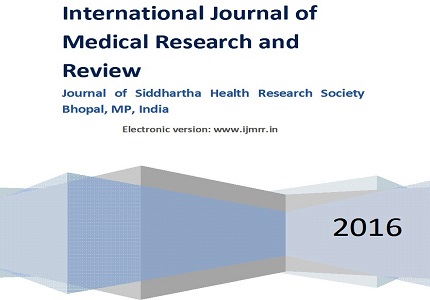Prevalence, typology and clinical correlates of sexual dysfunction among men with alcohol dependence syndrome
Abstract
Background: Chronic and persistent alcohol use is known to induce sexual dysfunction, but it is often unexplored and untreated in routine clinical practice.
Objective: To study the prevalence and typology of sexual dysfunction and its clinical correlates among male patients seeking treatment for alcohol dependence.
Materials and Methods: 60 male subjects (aged 18-50 years) meeting the criteria for alcohol dependence syndrome (ADS), according to DSM-IV were enrolled for the study. Data regarding socio- demographic and clinical details were recorded on a semi-structured proforma designed for the study. They were assessed for sexual dysfunction using a Sexual Dysfunction Checklist, constructed using items from the Diagnostic Criteria for Research (ICD-10) for sexual dysfunction and Arizona Sexual Experience Questionnaire (ASEX) and for severity of alcohol dependence using the Severity of Alcohol Dependence Questionnaire (SADQ).
Results: 58.3 % had one or more sexual dysfunction as per ASEX, the most common being inability to reach orgasm (60%), dissatisfaction with orgasm (58.3%) and erectile dysfunction (56.7%). As per sexual dysfunction checklist, dissatisfaction with own sexual performance (58.3%), anorgasmia (56.7%) and erectile dysfunction (53.3%) were the most common. Longer duration of alcohol consumption and dependence, high levels of intake and sever dependence appeared to be the most significant predictors of developing sexual dysfunction.
Conclusion: SD is highly prevalent in patients with alcohol dependence and all domains of sexual functioning are affected. Anorgasmia is quite common in patients with alcohol dependence. Longer duration of consumption and dependence and heavy drinking proportionately increases the risk. Clinicians need to routinely evaluate sexual functioning in alcoholic patients and address the same.
Downloads
References
World Health Organization. WHO Global Status Report on Alcohol and Health. Geneva, Switzerland: WHO;2014. Available at: http://apps.who.int/iris/bitstream/10665/112736/1/9789240692763_eng.pdf.
Obot IS, Poznyak V, Monteiro M. From basic research to public health policy: WHO report on the neuroscience of substance dependence. Addict Behav. 2004 Sep;29(7):1497-502.doi: https://doi.org/10.1016/j.addbeh.2004.06.019.
Gelder M, Gath D, Mayon R, Cowen P. Etiology of sexual dysfunction. In: Oxford Text book of Psychiatry, 3rd ed. Oxford, UK: Oxford University Press, 1996.
Grover S, Mattoo SK, Pendharkar S, Kandappan V. Sexual dysfunction in patients with alcohol and opioid dependence. Indian J Psychol Med. 2014 Oct;36(4):355-65. doi: https://doi.org/10.4103/0253-7176.140699.
Fahrner EM. Sexual dysfunction in male alcohol addicts: Prevalence and treatment. Arch Sex Behav. 1987 Jun;16(3):247-57.doi: https://doi.org/10.1007/bf01541612.
Fahrner EM. Sexual dysfunction in male alcohol addicts: prevalence and treatment. Arch Sex Behav. 1987 Jun;16(3):247-57.
World Health Organization. Alcohol Use and Sexual Risk Behaviour: A Cross-Cultural Study in Eight Countries. Geneva: World Health Organization;2005.https://www.who.int/substance_abuse/publications/alcohol_sexual_risk_crosscultural.pdf.
Peugh J, Belenko S. Alcohol, drugs and sexual function: A review. J Psychoactive Drugs. 2001 Jul-Sep;33(3):223-32.doi: https://doi.org/10.1080/02791072.2001.10400569.
Powers AD, Gleason ME, Oltmanns TF. Symptoms of borderline personality disorder predict interpersonal (but not independent) stressful life events in a community sample of older adults. J Abnorm Psychol. 2013 May;122(2):469-74. doi: https://psycnet.apa.org/doi/10.1037/a0032363.
Stockwell T, Murphy D, Hodgson R. The severity of alcohol dependence questionnaire: its use, reliability and validity. Br J Addict. 1983 Jun;78(2):145-55.doi: https://doi.org/10.1111/j.1360-0443.1983.tb05502.x.
World Health Organization. The ICD-10 classification of mental and behavioral disorders: Diagnostic criteria for research. World Health Organization: Geneva;1993.
McGahuey CA, Gelenberg AJ, Laukes CA, Moreno FA, Delgado PL, McKnight KM et al. The Arizona Sexual Experience Scale (ASEX): reliability and validity. J Sex Marital Ther. 2000 Jan-Mar;26(1):25-40.doi: https://doi.org/10.1080/009262300278623.
Arackal BS, Benegal V. Prevalence of sexual dysfunction in male subjects with alcohol dependence. Indian J Psychiatry. 2007 Apr;49(2):109-12. doi: http://www.indianjpsychiatry.org/text.asp?2007/49/2/109/33257.
Hartford JT, Samorajski T. Alcoholism in the geriatric population. J Am Geriatr Soc. 1982 Jan;30(1):18-24.doi: https://doi.org/10.1111/j.1532-5415.1982.tb03699.x.
O'Donnell AB, Araujo AB, McKinlay JB. The health of normally aging men: The Massachusetts Male Aging Study (1987-2004). Exp Gerontol. 2004 Jul;39(7):975-84.doi: https://doi.org/10.1016/j.exger.2004.03.023.
Rosen RC. Alcohol and drug effects on sexual response: Human experimental and clinical studies. Annu Rev Sex Res. 1991;2:119-79.
McCambridge J, Mitcheson L, Hunt N, Winstock A. The rise of Viagra among British illicit drug users: 5-year survey data. Drug Alcohol Rev. 2006 Mar;25(2):111-3.doi: https://doi.org/10.1080/09595230500537167.
Villalta J, Estruch R, Antunez E, Valls J, Urbano-Marquez A. Vagal neuropathy in chronic alcoholics: Relation to ethanol consumption. Alcohol Alcohol. 1989;24(5):421-8.
Muthusami KR, Chinnaswamy P. Effect of chronic alcoholism on male fertility hormones and semen quality. Fertil Steril. 2005 Oct;84(4):919-24.doi: https://doi.org/10.1016/j.fertnstert.2005.04.025.
Girish N, Kavita R, Gururaj G, Benegal V. Alcohol use and implications for public health: patterns of use in four communities. Indian J Community Med. 2010 Apr;35(2):238-44. doi: http://www.ijcm.org.in/text.asp?2010/35/2/238/66875.



 OAI - Open Archives Initiative
OAI - Open Archives Initiative


